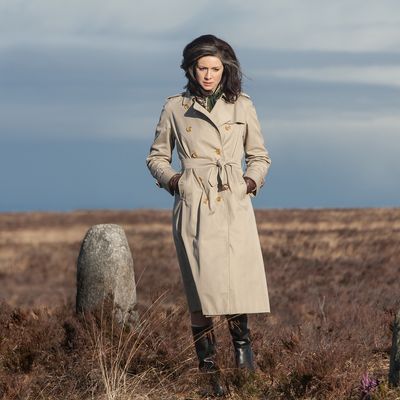
Spoilers ahead for the season finale of Outlander and the Outlander book series.
Did you get a Mrs. Robinson vibe in the Outlander season finale’s 1968 scenes? That’s because actress Caitriona Balfe was channeling her to portray older Claire, who will be our main Claire going forward (save for the occasional flashback). “We all decided early on that we didn’t want to do too much to Caitriona, in terms of the physical look,” co-executive producer Maril Davis said.”We tried to show Claire’s aging with a few subtle makeup things, and [the gray in] her hair,” Balfe added. “I wasn’t signing up for more time in the makeup chair than needed!”
Instead, they bring out Claire’s age more in how she carries herself. Balfe chose to reflect Claire’s maturity via her voice (a deeper register) and her posture. For inspiration, she watched films starring Helen Mirren, Charlotte Rampling, and Meryl Streep at different stages in their lives. “Claire has the weight of experience,” she said. “What kind of confidence would she have? She has 20 years of disappointment, sadness, and grief, so what does that do to someone? What does she carry, and what does she let go of?”
Since Claire was born in 1918, she’s either 50 or just about to turn 50 when we see her in 1968 (even if three of those years were spent in the 18th century). But as she mentions, she’s now a doctor (or as Brianna corrects her, a surgeon). So just how did she get here?
In the books, we learn more about her professional path, and how she is now the chief of surgery at a major hospital at a time when higher positions in medicine were almost exclusively male. The irony is, her trip back in time is what made this possible. Claire’s healing abilities, knowledge of modern medicine, and her experience as a WWII combat nurse put her in a position where she was the best doctor available in the 18th century, and she was encouraged to practice medicine by those who needed her services.
When Claire returns to 1948, she eventually realizes something is missing from her life. She likens it to a song from WWI, “How You Gonna Keep ‘em Down on the Farm (After They’ve Seen Paree)?” “I’d seen Paree,” Claire explains in Voyager. “And a lot of other things besides. I’d been a doctor, in every way there is — I’d delivered babies, set bones, stitched wounds, treated fevers … There was a terrible lot I didn’t know, of course. I knew how much I could learn — and that’s why I went to medical school. But it didn’t really make a difference, you know. I have a diploma with an M.D. on it — but I was a doctor long before I set foot in medical school.”
Claire also had more freedom in the 18th century, given her relationship with Jamie, which was more of a partnership than her marriage to Frank. “Jamie appreciates and makes sure she’s an equal partner in that time,” Davis said, “when normally she would not have been able to do the things she does. She had the freedom to become herself in a way that she would not have, had she stayed in the 1940s.”
The Claire we first met in the pilot is definitely a woman of her era: She stepped up to do what had to be done because of the war effort. “You have no idea how strong, and how individualistic, how singularly determined women during WWII were,” author Diana Gabaldon said. “The men were gone, and the women took over, and managed very, very well, not only in the nursing capacity, but also on the civilian side.” But when the war ended, women stepped back from those roles and started families.
Had Claire remained in 1945 and continued a normal life into the 1950s, she would have been expected to either stay a nurse or retreat from the workforce entirely, and focus on being a professor’s wife. Had she not gone through those stones, “she would have felt more shackled,” Davis said. “I don’t know if [she and Frank] would have had the happiest life.”




